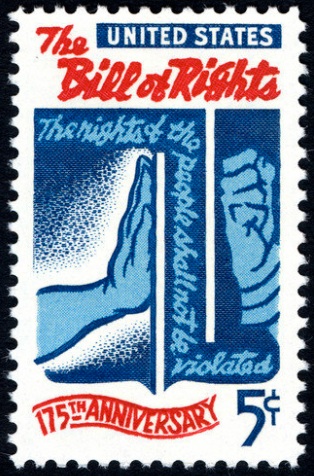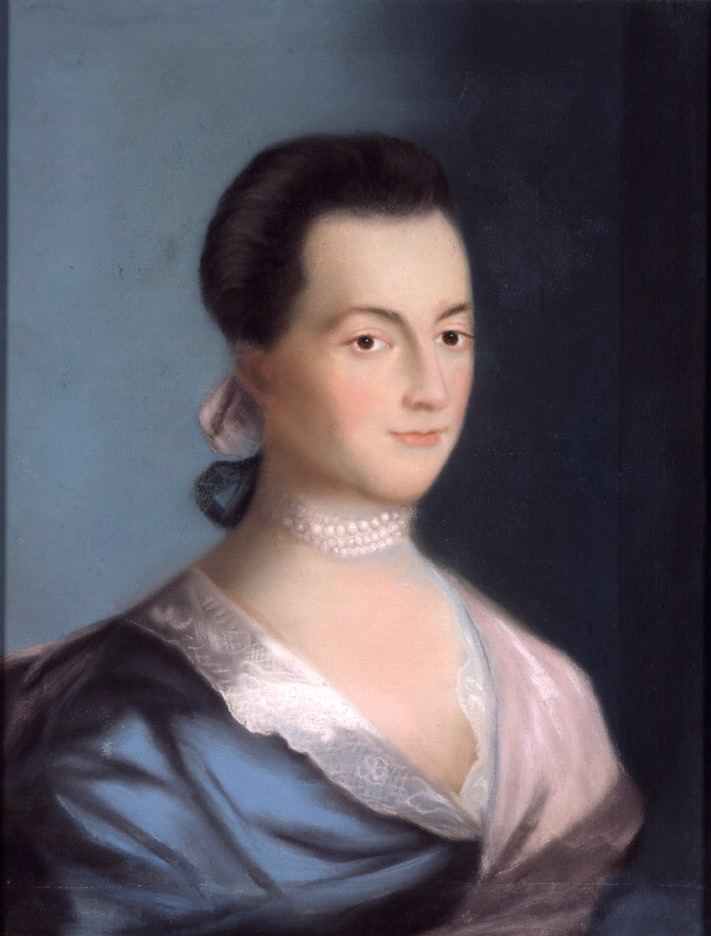 1966 Postage Stamp
1966 Postage Stamp
Topics on the Page
Summary of the United States Bill of Rights
Passage of the Bill of Rights
The influence of the British concept of limited government
- English Bill of Rights
The particular ways in which the Bill of Rights protects basic freedoms, restricts government power, and ensures rights to persons accused of crimes.
Other Bills of Rights in U.S. History
- GI Bill of Rights (Servicemen's Readjustment Act (1944)
- Patients Bill of Rights (adopted 1995)
- Student Bill of Rights
- Student Rights at School
- Transgender Student Rights at School
- Voters Bill of Rights (from Democratic National Committee)
- LGBTQ Rights in the United States
- LGBTQ Rights Around the World
- Bill of Rights for People of Mixed Heritage
- Debates over the Amendments
![]() CROSS-LINK: Shays' Rebellion in Massachusetts
CROSS-LINK: Shays' Rebellion in Massachusetts
![]()
Focus Question: What is the United States Bill of Rights?
Summary of the Bill of Rights
- Freedom of religion, speech, press, and peaceable assembly as well as the right to petition the government.
- Right to keep and bear arms.
- Protection from quartering of troops.
- Protection from unreasonable search and seizure.
- Due process, double jeopardy, self-incrimination, private property.
- Trial by jury and other rights of the accused.
- Civil trial by jury.
- Prohibition of excessive bail, as well as cruel and unusual punishment.
- Protection of rights not specifically enumerated in the Bill of Rights.
- Powers of states and people.
For more, including interactive games on the Bill of Rights, see Government 3.11![]() Musical Tributes to all 27 Constitutional Amendments
Musical Tributes to all 27 Constitutional Amendments
![]()
- For an overview of the Bill of Rights, watch this video from TED-Ed.
- The National Constitution Center in Philadelphia created this video for Constitution Day 2014.
- It gives insight into the Bill of Rights - how it was made, arguments behind the individual amendments, and more. This would be a great introduction for high school and/or AP students.
- For an-depth look at freedom of speech, see 45 Words: A Story of the First Amendment from the Newseum Digital Classroom.
- This page from the American Civil Liberties Union provides a brief history of the Bill of Rights but includes a section on how the Bill of Rights was not intended to provide rights for women or minorities.
- Native Americans were completely excluded from the Bill of Rights because they were not part of the constitutional system and lacked autonomy, but they were controlled by federal treaties and laws.
- The Bill of Rights only pertained to whites and slavery was protected by the Constitution for 78 years.
- Women were also excluded from the Bill of Rights and were viewed as the property of their husbands.
- The 13th, 14th, and 15th Amendments were the first steps toward equality (4).
King John Signing Magna Carta by Ernest Norman

This interactive timeline shows how the Bill of Rights first developed and how it changed over time.
- The timeline begins with the signing of the Magna Carta 1215 and ends with FDR's designation of December 15 as "Bill of Rights Day" in 1941.
- The Constitutional Convention worked on forming the Bill of Rights from May through September of 1787 and on September 16, 1789, the Bill of Rights was finally added to the Constitution (7).
![]()
This page provides multiple primary sources on the Federalist and Antifederalist debate. It has primary sources from the Constitutional Convention, documents advocating for the Bill of Rights, and excerpts from The Federalist Papers that were against the Bill of Rights (5).
Here is a link to Common Sense, by Thomas Paine.
- Seminal Primary Documents to Read: the Bill of Rights (1791)
- Seminal Primary Documents to Consider: Magna Carta (1215) and the English Bill of Rights (1689)
Focus Question: What factors contributed to its passage?

The adoption of the Constitution was a huge victory for the Federalists who sought a stronger role for a more structured central governing force.
Passage of the Bill of Rights, or the first ten amendments of the Constitution, was a concession to Jeffersonian Democrats who would otherwise have withheld their support.
It was, in essence, an agreed upon condition for ratification.
The rights and powers of the national government were limited in the Constitution to those specifically enumerated in its articles, but Democrats sought explicit protections for citizens from abuse at the hands of an unfettered central authority.
![]()
- This site has a number of lesson plans on the Bill of Rights.
- Here is an 8th grade lesson plan for the Bill of Rights from John Sevier Middle School
- This page from the Bill of Rights Institute offers free lesson plans on the Bill of Rights, as well as the political figures who influenced them, the Federalist and Anti-Federalist Papers, and landmark cases dealing with the Bill of Rights.
Interactive Resources
- Click here to play "Do I Have A Right: Bill of Rights" in which you run a firm of lawyers who specialize in the Bill of Rights. This game tests how well you know the Bill of Rights.
- This interactive game will help students visualize what the United States would be like if there was no Bill of Rights. Students will go throughout the virtual town of Freeville to find freedoms to rebuild the Bill of Rights after the Official National Computer has crashed (8).
- Click Here to play Annenberg Classroom's That's your Right: an interactive card game that tests your knowledge of the Bill of Rights. The game can be played vs an AI or can be played in multiplayer.
British Concept of Limited Government
- British Philosopher John Locke described a constitutional system in his writings. This system influenced founding American politicians.
- Great Britain operated under a form of limited government.
- British colonists brought to North America their ideas of limited government and individual freedom. These ideas blossomed into the Civil Rights and Civil Liberties that we know today.
English Bill of Rights (1689)
British settlers in the New World brought with them a tradition of setting limits on the power of government over ordinary citizens. Britain was governed by a constitutional monarchy whereby the King or Queen was forced to share power with a democratically elected Parliament. After the assembly had installed William and Mary as sovereigns they presented the new monarchs with a Bill of Rights which codified Parliament's power to pass laws and levy taxes, and the rights of citizens to bear arms and get a trial by jury when accused of a crime.
This article gives an overall history of the Bill of Rights but also provides a video and goes into depth of its background. The Magna Carta was signed by King John of England in 1215 to protect subjects from royal abuses of power and the English Bill of Rights was passed after the Glorious Revolution in 1689. Amendments included in the English Bill of Rights were seen in the American Bill of Rights. American colonies also used written documents to protect the rights of individuals, such as the 1606 Charter for Virginia. These examples led to the development of the Bill of Rights (6).
The Bill of Rights Protects Basic Freedoms, Restricts Government Power, and Ensures Rights to Persons Accused of Crimes

Shown in the mural are (from left to right) James Madison (standing), speaker Frederick Muhlenberg (seated), Elbridge Gerry (standing, foreground), and Fisher Ames (standing, rear). Left: A preacher conducts an open-air service, symbolizing the freedom of religion that is assured by the First Amendment to the Constitution. Right: A printer at work represents another First Amendment right, freedom of the press. (from the Architect of the U.S. Capitol)
- Bill of Rights consists of the first ten amendments to the United States Constitution.
- The most basic of all freedoms are protected under the first amendment: "Congress shall make no law respecting an establishment of religion, or prohibiting the free exercise thereof; or abridging the freedom of speech, or of the press; or the right of the people peaceably to assemble, and to petition the Government for a redress of grievances."
- Government power is restricted by prohibiting it from making any law regarding religion, and by not allowing the government to intervene in any persons life, liberty, or property "without due process of law."
- The rights of persons accused of crimes are preserved by the fifth, sixth, and seventh amendments which respectively state:
- "No person shall be held to answer for any capital, or otherwise infamous crime, unless on a presentment or indictment of a Grand Jury, except in cases arising in the land or naval forces, or in the Militia, when in actual service in time of War or public danger; nor shall any person be subject for the same offence to be twice put in jeopardy of life or limb; nor shall be compelled in any criminal case to be a witness against himself, nor be deprived of life, liberty, or property, without due process of law; nor shall private property be taken for public use, without just compensation."
- "In all criminal prosecutions, the accused shall enjoy the right to a speedy and public trial, by an impartial jury of the State and district where in the crime shall have been committed, which district shall have been previously ascertained by law, and to be informed of the nature and cause of the accusation; to be confronted with the witnesses against him; to have compulsory process for obtaining witnesses in his favor, and to have the Assistance of Counsel for his defense."
- "In suits at common law, where the value in controversy shall exceed twenty dollars, the right of trial by jury shall be preserved, and no fact tried by a jury, shall be otherwise reexamined in any court of the United States, than according to the rules of the common law."
One of the key features of the U.S. Constitution is the fact that it is open to amendment (although not easily).
- This makes it a work in progress which can and should be brought in line with contemporary circumstances.
- The seven Articles contained in the Constitution proper are largely taken up with house-keeping - they delineate the structures of government in order to guarantee that power is shared rather than concentrated thus prohibiting its abuse by one or a few rulers.
The Constitution is remarkably devoid of statements of philosophy or declarations of rights.
- This is probably why the first ten amendments are set off from those that followed - they directly complement the original document and are largely viewed as part of it.
- The first amendment looms largest in this regard. In many ways, five key amendments are packed into one concise paragraph.
- The separation of church and state is clearly established - no religious test for office holders.
- Conversely, the state may not interfere in the affairs of religious orders.
- It goes on to frame our understanding of the right to free speech in all its dimensions.
- The remaining amendments outline what Americans have come to expect of their rights of citizenship and given us the language to form these discussions: civil rights; rights of privacy; and the right to due process.
- Whereas the Constitution is deliberately vague and delivers on structure rather than substance, the Bill of Rights gives us specifically enumerated guarantees which hugely impact our daily lives as citizens.
The Bill of Rights is absent on addressing issues of race or gender: see this page of the wiki for information on the development of civil liberties and civil rights by judicial interpretation.
![]()
Part One YouTube Video on Creation of Bill of Rights
Part Two of the Video on Amendments to the Bill of Rights
Other Bills of Rights in U.S. History
Franklin Roosevelt, October 1944

For a modern perspective on the Bill of Rights, see Franklin D. Roosevelt Second Bill of Rights (also known as the Economic Bill of Rights) Speech, State of the Union Address, January 11, 1944.
GI Bill of Rights (Servicemen's Readjustment Act (1944)
Patients' Bill of Rights (1995)
 |
| Abigail Adams by Benjamin Blythe, 1766 |
Click here for selections from Letters between Abigail Adams and her Husband John Adams on women's rights. Abigail Adams is viewed by many historians as being an equal to her husband, a Federalist, in terms of political sway.
This site has an online annotated Bill of Rights, including the legal history of each amendment. See also, Short Annotation of the Bill of Rights.
![]()
LBGTQ Rights and Same-Sex Marriage
Health Care Bill of Rights, LGBT Health Link (2019)
Justice Anthony Kennedy wrote the majority opinion overturning the Defense of Marriage Act in 2013
 |
| |
The Supreme Court and Gay Marriage explores constitutional issues raised by the Defense of Marriage Act (DOMA).
See also, Constitutional Amendments and Gay Marriage from PBS Newshour, and Between the Lines of the Defense of Marriage Act Opinion from the New York Times, June 26, 2013.
Supreme Court Ruling overturning DOMA (Defense of Marriage Act) in 2013.![]() For a broader overview of Supreme Court cases and a 2014 map of Gay Marriage states, see The Gay Rights Controversy from the University of Missouri, Kansas City.
For a broader overview of Supreme Court cases and a 2014 map of Gay Marriage states, see The Gay Rights Controversy from the University of Missouri, Kansas City.
 |
| Tammy Baldwin, first openly gay U S Senator |
Openly Gay, and Openly Welcomed in Congress from the New York Times (January 26, 2013) discusses the 6 gay or bisexual House members and one gay senator of the 113th Congress, all democrats.
Click here for Tammy Baldwin's Senate website
LGBT Rights Around the World Infographic (2015)
As of 2015, there are no amendments addressing sexual orientation.
Bill of Rights for People of Mixed Heritage
Dr. Maria P.P Root's Bill of Rights for Racially Mixed People
This video is only one minute and reflects on the wide spanning impact of the Bill of Rights for People of Mixed Heritage
How the Bill of Rights effects us today:
- Click here for a historical timeline of gun control in the U.S. and the call for it in 2018.
Transgender Students' Rights at School
What are My Rights at School? National Center for Transgender Rights
Transgender Rights, ACLU
- The Rights of Transgender People in Washington State, Washington ACLU
Know Your Rights, Lambda Legal
Equality Maps, Transgender Law Center
![]()
Lesson Plans to Help Students Understand Gender and to Support Transgender and Non-Binary Children, Welcoming Schools, Human Rights Campaign Foundation
Bibliography
[1] Bill of Rights. Retrieved April 12, 2007, from TeachingAmericanHistory.org. http://teachingamericanhistory.org/library/index.asp?document=972
[2] Civil Rights and Civil Liberties. Retrieved April 12, 2007, from History.com. http://www.history.com/encyclopedia.do?articleId=205791
[3] United States Bill of Rights. Retrieved April 12, 2007, from Wikipedia.com. http://en.wikipedia.org/wiki/United_States_Bill_of_Rights
(4) https://www.aclu.org/bill-rights-brief-history
(5) http://teachingamericanhistory.org/bor/fed-antifed-debate/
(6) http://www.history.com/topics/bill-of-rights
(7) http://cdn.knightlab.com/libs/timeline/latest/embed/index.html?source=0AvpekUqA4rwKdFg0UklRRUhNNnNRT3JrQnFCWTBPWXc&font=Bevan-PotanoSans&maptype=toner⟨=en&height=650
(8) http://constitutioncenter.org/billofrightsgame/